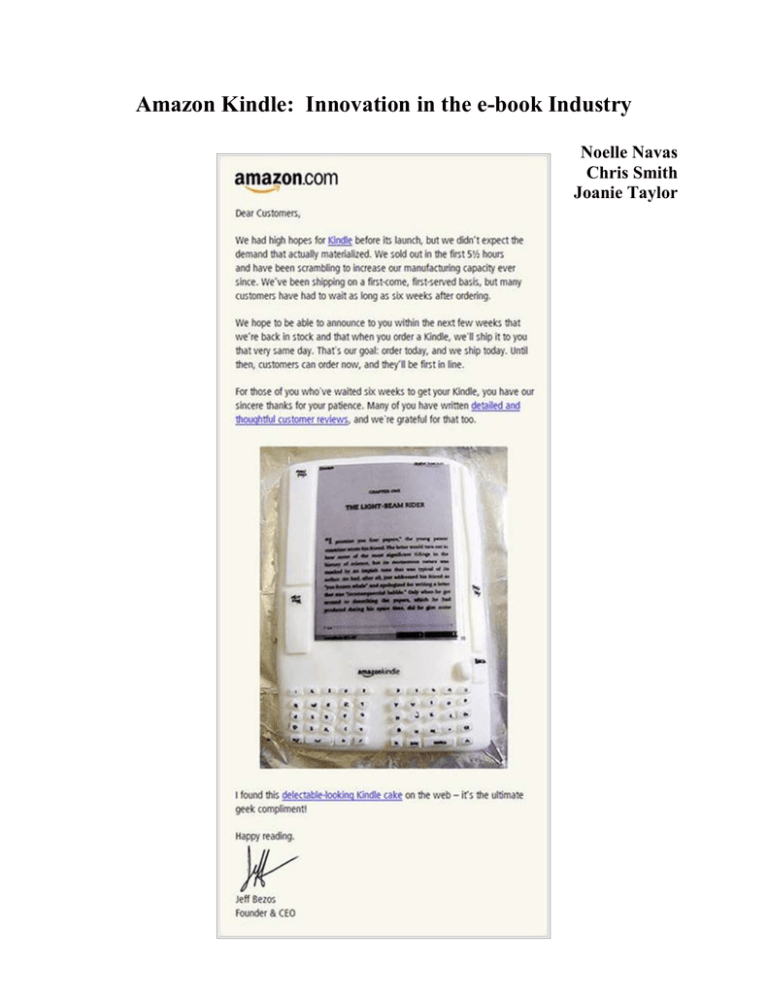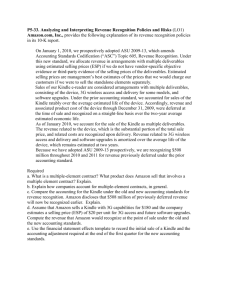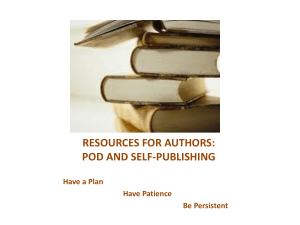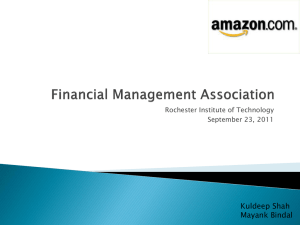EIS_Kindle_Navas_Smith_Taylor
advertisement

Amazon Kindle: Innovation in the e-book Industry Noelle Navas Chris Smith Joanie Taylor EIS Mini-Project October 11th, 2010 Amazon Kindle: Innovation in the e-book Industry The e-book has a history that is almost 30 years old but only recently have events in this burgeoning industry made the widespread adoption of the e-book seem likely. The decision by Amazon (“Amazon” or “the Company”) to create and implement an innovation ecosystem to produce the Kindle contributed to a sizeable shift in industry momentum. The Company’s ability to effectively manage their innovation risk and the singular fact that the Kindle’s innovation ecosystem wonderfully folds into their overarching strategy makes the Amazon Kindle a case worth investigating. The Kindle Value Vision Stated in the plainest manner, the value vision of the Amazon Kindle is to be the “Book 2.0.” This vision is best captured by Jeff Bezos, Amazon of CEO when he states “if you're going to do something like this, you have to be as good as the book in a lot of respects…but we also have to look for things that ordinary books can't do.”1 At the Kindle’s release in 2007, this list of benefits included a key feature never incorporated in e-Reader predecessors: constant wireless connectivity. Through a system called the Whispernet (based on a broadband -based service similar to that of a cell network), the Kindle was constantly connected to the bookstore. Thus, the reader not only carried a book shelf of 200 books inside her Kindle, but she could instantly connect to the Amazon library to order (almost) any book or periodical she could think about. When thinking about value as the quantifiable difference between benefits and costs, it was this ability that differentiated the Kindle. We do not believe that this difference can be understated in the discussion of why the Kindle was a disruptive threat to not only other e-Readers, but also to the conventional book. The ability to download a book from anywhere, never having to plug your Kindle into a PC, or find a Wi-Fi hotspot, meant that the Kindle was transformed from being simply an electronic book reader, into a service. This service allowed the reader to tap into a deep well of literature and periodicals. More importantly, this service was expertly supplied by the massive platform that was Amazon.com. Value Chain The value chain for the Kindle is displayed in the figure below: Row 1 Author Publisher Kindle Amazon Consumer Wireless Carrier Row 1 represents the typical value chain for the standard book sold through Amazon. The addition of the Kindle (or any e-Reader) to the value chain and the wireless carrier (or Wi-Fi system) changes the graphic into an e-book value chain. A Short History of E-books The first e-books (or digital books) were born in 1971 from a collaborative effort called “Project Guttenberg” and were intended to complement the Dynabook, one of the first portable computers.2 Although the transition to digital media was an important event in the long history of the book, appropriate complementors were not well enough established to allow the general public to benefit from this radically new version of the book. Over time, the advent of new, complementary technologies would allow increasingly larger numbers of people to utilize digital books. First the CD-ROM, then the Internet, would allow access to greater numbers of e-books. However, significant influencers within the book industry needed to adopt this innovative technology in order to increase the use of e-books. The first of these was the public library system. In 1998, the public libraries in the U.S. began to offer digital books, although they were primarily scholarly, technical, or professional books.3 Over the next six years, public libraries would increase their use of e-books to include popular books through the use of online lending libraries. The second major influencer was Google, whose “Google Print” project brought a million widely read books to the internet.4 The third, and arguably most important, player was the book publishers, whose adoption was critical if the e-book ever hoped to become a wide-spread commercial success. As a critical member of the e-book value chain, true explosion of the e-book industry is completely impossible without publishers such as Penguin, Random House, and HarperCollins fully embracing the use of the product. A significant milestone in this adoption was crossed in 2001 when HarperCollins became one of the first large commercial book houses to publish e-books.5 By 2008, major publishing houses such as Penguin books were publishing all new titles in both print and digital format while simultaneously digitizing their backlist.6 Directly driving, and limiting, the rate of adoption for e-books was the competition for the right device upon which to read digital books. Those who wished to take advantage of the inevitable rise of ebooks were searching for the right size, shape, screen, and format upon which to read e-books. Obviously PCs were the logical device for reading digital books, but did not seem to give readers the same satisfaction as reading “real” books. The first dedicated e-book readers were brought to market in 1998. At the time of launch for the Amazon Kindle in 2007, Sony was dominating the e-Reader marketplace. Another important ingredient in this competition was the fractured evolution of format for packaging and publishing e-books. In the early stages of the industry, multiple formats were used by many independent e-book publishers, further segmenting the industry and slowing the rate of adoption. Through the 2000s, the Adobe PDF and EPUB formats became one of the most widely used formats for many e-Reader devices, although by no means the exclusive formats.7 Why Discuss the Kindle and not the Sony Reader? Amazon’s decision to build an innovation ecosystem around the Kindle was not only a significant departure from its core business, but also a masterstroke. The Company was historically a truly great online retail platform, but not a major manufacturer of cutting edge technologies. As mentioned above, Sony, an established and savvy electronics device maker, launched an appealing e-Reader in 2006 called the Reader. Naysayers of the Amazon vision could easily have challenged Jeff Bezos’ decision to go head-to-head with Sony in a device manufacturing contest. Yet, Amazon carefully picked how the Kindle would compete with the Reader. The Company did not choose to go to market with a device that was multiple generations ahead of the Reader, but instead relied on innovations, like the Whispernet, that were incremental. Moreover, these innovations would undoubtedly be copied within a relatively short amount of time. Fundamental to the strategy was the idea that the e-Reader market was an expanding pie that exquisitely complemented the Company’s core competency of selling books. Viewing the Kindle as both a product and a service reveals that this strategic choice was a disruptive addition to their technology knowledge, but was very much a competence enhancing strategy on account of their market knowledge of selling books. The many relationships and competencies that Amazon had in place with players such as publishers complemented the market-knowledge required to make the service of selling books that differentiated the Kindle. Selling the Kindle product has been, and will continue to be, a profitable business. However, should Amazon decide to stop competing in the e-Reader device competition, the widespread adoption of the e-book driven through the Kindle, and its competition, allows Amazon to continue to profit from the service of selling e-books. The fact that Amazon currently sells the Barnes&Noble Nook, the Sony Reader, and the Apple iPad clearly demonstrates Amazon’s strategy. Fundamental to our analysis is that Amazon understands the idea of using the Kindle to help ensure survival in the short-term so the Company may continue to compete in the long-term. Amazon’s commitment to developing the innovation ecosystem around the Kindle accelerates the adoption of the e-book, where Amazon has taken a strategic high-ground. Innovation Strategy When Jeff Bezos announced the delivery of the Kindle, his expectation for the device focused on both the digitizing of books and the actual launch of an e-Reader. Bezos planned for the Kindle to be a turning point in the transformation toward “Book 2.0.” He identified the need for long form reading to be digitized since short term reading had already been digitized beginning with the Web. He also hoped that the Kindle’s sales would leapfrog competitor e-Readers in the market. In short, Bezos’ strategy for the Kindle was to create a superior e-Reader that would significantly drive the e-book market.7 The creation of the Kindle also communicated Amazon’s vision for the future. Amazon described the Kindle’s creation as a revolution in a time when the publishing industry was battling with television, Sony’s Wii and the BlackBerry in a fight for consumers’ leisure time. The Kindle, in Amazon’s vision, would, “…change the way readers read, writers write and publishers publish.” 7 The expectation was to develop the best reading experience for a target market that catered to the segment of customers who were avid readers. Even today, the Kindle is not directly competing with the iPad. The Kindle is, in fact, truly targeted at customers who are voracious readers. Amazon continues to be committed to focusing the Kindle as a low-end, dedicated product that revolutionizes reading.8 As Amazon chose the innovation strategy that would shape their ecosystem, the Company elected to pursue a strategy based on incremental innovation improvements that focused on making the Kindle more of a service to its customers rather than a technologically daunting e-Reader device (as its competitors had done). Amazon’s vision for the Kindle was to improve the availability and downloading process of e-books. The product would offer internet-free wireless connectivity, which none of its predecessors had previously offered, and would continue to increase their feature offerings in small steps after the Kindle entered the market. Kindle users could have a book with one touch and begin reading immediately. In addition, it is likely that Amazon has a long list of further developments to make to the Kindle in order to set apart its reading experience from its competitors.8 Amazon was committed to creating a product that not only met the consumer’s threshold on functionality, but also focused on convenience. In addition to Amazon’s deliberate planning in regards to the actual product offering, Amazon’s success with the Kindle is attributable to a strategy that accounted for the delays and challenges inherent in their collaborative ecosystem. Amazon did an outstanding job of managing its risks by creating an ecosystem where Amazon internalized most of its co-innovation risk and the company was able to control and be responsive to most risks Co-innovation Risk In Amazon’s innovation ecosystem, co-innovation risks were extensively considered and then minimized. Amazon effectively identified potential weaknesses that could arise from their core business being retail, not manufacturing, before stepping into the manufacturing process during the development of the Kindle. The Company recognized that it would be dependent on the Kindle’s hardware and software suppliers for development and therefore Amazon knew that it would have less control over its own success. Amazon was able to mitigate this interdependence risk by acquiring the pieces of the manufacturing puzzle that the Kindle required. In return, this increased the probability of success for all development phases of the project. Amazon executed an aggressive acquisitions strategy in order to enhance its position. It acquired a hardware company, Lab126, to develop and manufacture the device and further controlled its format development issues through the acquisition of Mobipocket. Additionally, Amazon acquired Audible.com, Shelfari and Abebooks in an effort to control all production and associated risks with the development of content. Amazon also partnered with E Ink, an electronic screen technology which had already been developed, to provide a realistic and enjoyable reading experience. Through Amazon’s acquisition of these key suppliers, the company was able to effectively manage production expectations and co-innovation risks were minimized. Because Amazon was able to internalize the largest part of its development risk through acquisitions, Amazon’s biggest interdependence risk was shifted to the publishing companies. Without digitized books, Amazon’s whole strategy could be completely dismissed. Amazon would not be able to make a critical impact on the market without the publishers. Fortunately for Amazon, relationships with publishers had already been developed through its core business, Amazon.com. Through Amazon’s pressure on publishers to release digital versions, 88,000 Kindle compatible e-books were on sale at the time of the Kindle’s launch (compared to approximately 45,000 available for the Sony Reader). Many publishing companies agreed that the process was a real chokepoint due the expensive nature of scanning books—which led many publishers to be slow in digitizing back listed books. Publishers also showed resistance towards Amazon’s pricing of e-books; however, Amazon’s strategy of low margins and high volume enabled them to charge less for an e-book and alleviate its interdependence risk with publishers. Initiative Risk Amazon had several initiative risks when creating the Kindle. At the point that Amazon was developing the Kindle, one important initiative risk was the on-time delivery of an e-Reader that would have commercial appeal. The current players in the e-Reader market were not remarkably successful and even influential players in the portable electronics industry, such as Apple’s Steve Jobs, publically criticized the e-Readers. “It doesn’t matter how good or bad the product is, the fact is that people don’t read anymore,” Jobs remarked. It was clear that the Kindle must provide not only the benefit of being an electronic substitute to books, but other additional real benefits would have to be delivered to customers to prove that the Kindle was not just another e-Reader. Amazon had to enter the market with breakthrough advantages to the customer in order to minimize its initiative risk. History, and strong sales, demonstrates that Amazon was able to produce and release a product that was reader-friendly, provided a convenient service, and allowed the reader to effectively store bookshelves of personally chosen e-books. Adoption Chain Risk History is littered with well-designed products that never make it to the end user due to breaks in the adoption chain. Amazon managed adoption chain risk by levering its position as the premier online book seller to reach out directly to consumers. Because Amazon was the retailer, in addition to being the manufacturer, once a Kindle was ready to ship, there were only two more steps before it could reach the consumer. First, the consumer had to order it, and second, Amazon had to send it out. Because Amazon owned the retail channel, it was able to dedicate significant real estate on the website to both promoting the Kindle and educating consumers about the product. Serving as the sole retail channel meant that Amazon could provide consistent messaging about the product. And, as a bonus, it could expect to have new customers visiting Amazon.com because they read about the Kindle in the press. Often manufacturers must incentivize a retailer for preferred product promotion with means such as improved margins or exclusive special offers and even then, the retailer may decide to not feature the product if it is not in a strategic category for the retailer or if the retailer could make more money by promoting another product. It is likely that sales for the Sony Reader, which sold through such retailers as Target, Waterstone and Amazon suffered from not having a dedicated retail channel, the way that the Kindle did at Amazon.com. In addition to simply having a dedicated retail channel for the Kindle, Amazon knew that it had the ideal dedicated retail channel for an e-Reader. Amazon customers already turned to Amazon for books and content and, by virtue of shopping online, they self-identified as readers comfortable with technology. This built-in customer base was an important asset to Amazon as it began promoting the Kindle. Amazon also had the advantage of running experienced fulfillment centers. This meant that Amazon was easily able to process orders and get Kindles out to customers with minimal effort or complications. If another manufacturer tried to enter the fulfillment business to be able to ship directly to customers, the manufacturer would have a steep learning curve and would risk frustrating customers with mistakes in the orders and shipping. While adoption chain risks focus on who needs to adopt the technology before it can reach consumers, it is worth noting three assumptions that Amazon had to make to ensure that the Kindle would remain a success. First, Amazon had to assume that publishers would continue to provide fresh new content that readers wanted to read. This is a safe assumption because Amazon is a major customer of printed content for these publishers and the publishers, who often compete to sign hot new authors, are charged with selling as many books as possible for their clients. Second, Amazon had to assume that Kindle readers would, at least periodically, have access to electrical power to recharge the device. This is a safe assumption because much of the target audience, the developed world, has constant or periodic access to electrical outlets. A missionary heading out to a powerless part of the rainforest for five months would still need to pack paperbacks. Third, Amazon had to assume that Kindle readers would have access to wireless service at least as often as they were ready to download new content. This third one proved to be a challenge for international expansion, which we will address in a moment, but in general, wireless providers are incentivized for their own business to rapidly increase coverage area and so it was a safe assumption that customers would be able to gain access to the internet or a wireless cell signal. Informed Expectations Successful ecosystem management requires adjustments to expectations during the course of the innovation process. In the case of the Kindle, Amazon appears to have made expectation adjustments in at least a few strategic areas: international rollout, order quantities and feature modification. The UK is an important market for Amazon, as it is one of the Company’s largest international markets as well as an English-speaking market that could share content digitized for the American market. While it is difficult to ascertain the original planned launch date for the Kindle in the UK, articles surrounding the European launch hint at delays due to complications with wireless carriers in Europe. One of the benefits of the Kindle in the US was being able to download books as you travel through the states. While the British similarly travel around the Continent for leisure and business, complications with carriers in different countries proved to be a significant challenge to adoption. In an interview in October of 2008, the managing director of Amazon in the UK explained that “the Kindle is based on wireless technology. If you need agreement with carriers in the US, there is one carrier. In Europe it is a minefield as there are so many operators.”9 A second major adjustment had to be made in the quantity manufactured after the Kindle sold out only hours after its initial release. It is unclear whether Amazon strategically launched with a quantity it knew would sell out quickly in order to generate positive buzz, or whether Amazon was genuinely and dramatically overwhelmed by demand. In an open letter some five months later that was posted on the Amazon site and immortalized on a PC Web blog, Jeff Bezos wrote, “we had high hopes for the Kindle before its launch, but we didn’t expect the demand that actually materialized. We sold out in the first 5 1/2 hours and have been scrambling to increase our manufacturing capacity ever since.”10 The company established a policy of fulfilling Kindle purchases in the order that they were received, so customers signed up on a waiting list. Customers waited as much as six weeks to receive their Kindle. It is unlikely that Amazon was restricting production strategically since it needed to be known for quick delivery in order to compete with bricks-and-mortar stores. We also noted before that the Kindle was meant to be more of a service than simply a device and, in this case, it seems that Amazon would want as many customers as possible downloading as much content as possible. A third key area for expectation modification was the features set that would be available on the original Kindle. Designers on a fixed launch schedule often find that they must sacrifice certain features that are proving to be problematic in order to deliver the product on time. We cannot know for sure which features Amazon intended to be on the initial Kindle but the fact that they are still updating features with new models suggests that they had to leave features off of the original models. Recently added features include Wi-Fi capabilities, more font sizes, password protection, increased storage (3,500 books!), text-to-speech for English language content (the Kindle can read out loud to the user), and a new screen with improved contrast for a better reading experience. Amazon has also negotiated with more international wireless carriers and claims that the Kindle now works with networks in 100 countries and territories.11 Conclusion In the end, Amazon strategically managed its innovation ecosystem to achieve a successful launch of its e-Reader. Amazon was not the first mover in the e-Reader space and knew that its e-Reader would be judged strictly on relative benefit. After committing to the e-Reader concept, Amazon identified the features that would provide an ideal user experience and then set about leveraging its existing relationships and forging new ones via contracts and acquisitions to control as much of the innovation process as possible to improve the chances for success. Three years later, in 2010, Amazon’s decisions to acquire hardware and software companies and to insist on wireless download appear to be paying off. The Kindle is the market leader, and Amazon remains the premier online bookstore. Amazon continues to sell other e-Readers, including the Sony Reader, but Kindle is clearly the star. In July of 2010, Amazon announced that it had sold more e-books than hardcover books in the previous three months. Jeff Bezos has called this rapid adoption of the Kindle and e-publications “astonishing when you consider that we’ve been selling hardcover books for 15 years, and Kindle books for 33 months.”12 Even the introduction of Apple’s iPad does not appear to have slowed Kindle sales. The iPad is in fact credited with boosting sales as Amazon wisely decided to make all e-books purchased on Amazon available to read on computers, iPhones, iPads, Blackberries and Android smart devices, in addition to the Kindle. Thanks to the attention paid to consumer preferences during the Kindle design process, the New York Times reports that many iPad owners view the iPad and Kindle as complementary devices and prefer to own both. Because Amazon owns significant compelling content in addition to a compelling e-Reader, the Company appears to be extremely well positioned for the now inevitable mainstreaming of e-books. Endnotes Steven Levy, “The Future of Reading,” Newsweek, November 17, 2007, http://www.newsweek.com/2007/11/17/the-future-of-reading.print.html. 1 Alan Kay and Adele Goldberg, “Personal Dynamic Media,” The New Media Reader, http://www.newmediareader.com/book_contents.html. 2 3 Doris Small Helfer, "E-books in libraries: some early experiences and reactions," Searcher, October 1, 2000, http://www.highbeam.com/doc/1G1-66217098.html. Dian Schaffhauser, “Google Book Search: The Good, the Bad, & the Ugly,” Campus Technology, January 1, 2008, http://campustechnology.com/articles/2008/01/google-book-search-the-good-the-badamp-the-ugly.aspx. 4 Lisa Herling, “HarperCollins Announces First Global E-Book Publishing Program,” HarperCollins Publishers, February 20, 2001, http://www.harpercollins.com/footer/release.aspx?id=66&b=&year=2001. 5 Bharat Anand, “eReading: Amazon’s Kindle,” Harvard Business School case 709-486, December 9,2009. 6 Karie Kirkpatrick, “Injecting Life Into the Ebook: Adobe Digital Editions 1.0 Released,” Information Today, Inc., July 2, 2007, http://newsbreaks.infotoday.com/nbReader.asp?ArticleId=36819. 7 8 Interview with Vera Guerreiro, T’11 (Amazon Kindle Summer Associate). 9 Sarah Butler, "No UK Kindle Launch Before Xmas," TheBookSeller, October 17, 2008, http://www.thebookseller.com/news/69174-no-uk-kindle-launch-before-xmas.html. Melissa Perenson, “Amazon Acknowledges Kindle Shipping Delays,” PC World, March 21, 2008, http://blogs.pcworld.com/staffblog/archives/006675.html. 10 11 Amazon.com Kindle product description, Amazon.com, http://www.amazon.com/Kindle-Wireless-Reader-WifiGraphite/dp/B002Y27P3M/ref=amb_link_354201962_4?pf_rd_m=ATVPDKIKX0DER&pf_rd_s=center -1&pf_rd_r=0YM5306ETJHJCK83W1VA&pf_rd_t=101&pf_rd_p=1277208562&pf_rd_i=507846. Claire Cain Miller, “E-Books Tops Hardcovers at Amazon.” NY Time, July 19, 2010, http://www.nytimes.com/2010/07/20/technology/20kindle.html. 12





